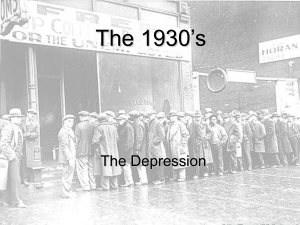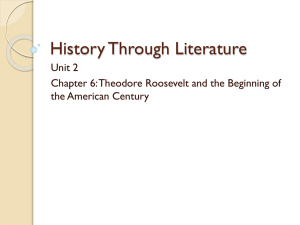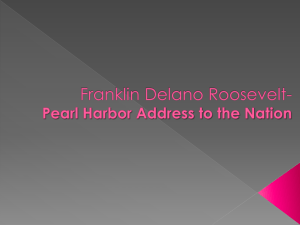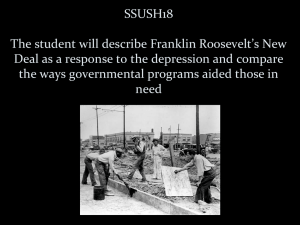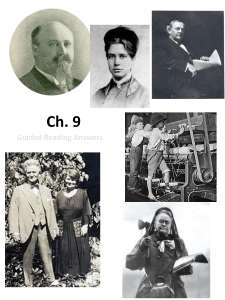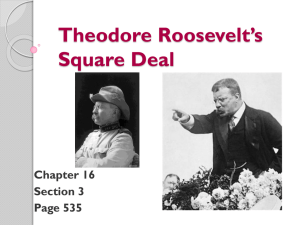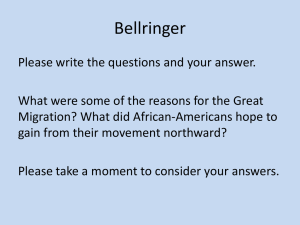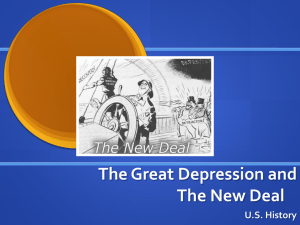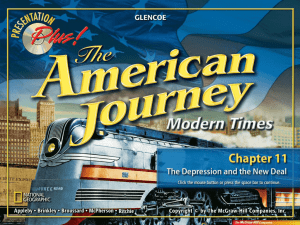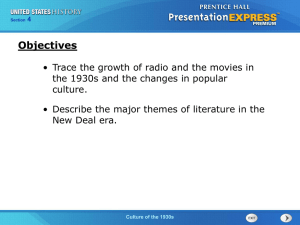CH015Pres
advertisement
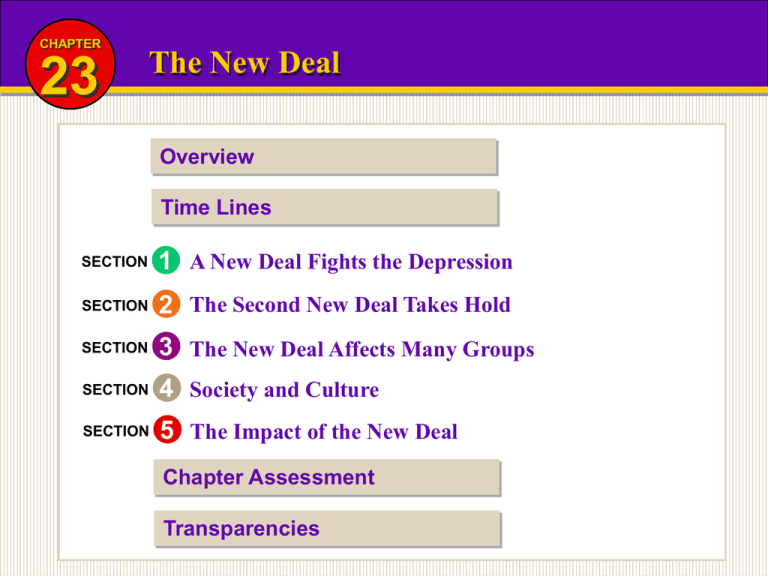
CHAPTER 23 The New Deal Overview Time Lines SECTION 1 A New Deal Fights the Depression SECTION 2 The Second New Deal Takes Hold SECTION 3 The New Deal Affects Many Groups SECTION 4 Society and Culture SECTION 5 The Impact of the New Deal Chapter Assessment Transparencies CHAPTER 23 The New Deal “The only thing we have to fear is fear itself.” President Franklin Delano Roosevelt THEMES IN CHAPTER 23 Economic Opportunity Cultural Diversity Science and Technology HOME CHAPTER 23 The New Deal “The only thing we have to fear is fear itself.” President Franklin Delano Roosevelt What do you know? • What do you already know about the New Deal? • What policies were created under the New Deal and who was affected? Read the quote above and answer the following: • What did Roosevelt mean? What can happen when people are afraid? • What else might people have feared in the 1930s? • What effect do you think Roosevelt hoped this statement would have on the American people? HOME CHAPTER 23 Time Line The United States 1933 Congress creates the TVA. 1934 Congress creates the SEC. 1935 Supreme Court declares the NIRA unconstitutional. The CIO is organized. Congress passes the Social Security Act. 1937 Labor unions begin using sit-down labor strikes. Snow White and the Seven Dwarfs is released. 1938 Fair Labor Standards Act passes. 1939 Marian Anderson sings at the Lincoln Memorial. John Steinbeck publishes The Grapes of Wrath. HOME CHAPTER 23 Time Line The World 1933 Hitler and the Nazi Party take power in Germany. Japan withdraws from the League of Nations. Batista overthrows the Cuban government. 1934 Chinese Communists engage in the Long March. Lázaro Cárdenas becomes the president of Mexico. 1935 Italy invades Ethiopia. British Parliament passes Government of India Act. 1936 Civil War begins in Spain. Soviet leader Joseph Stalin purges Communist Party and government leaders. 1937 Japan invades China. 1939 Germany invades Poland. HOME SECTION 1 A New Deal Fights the Depression Learn About the early actions taken by the Roosevelt administration. To Understand how the New Deal tried to combat the Depression. HOME SECTION 1 A New Deal Fights the Depression Key Idea President Roosevelt takes many actions to combat the Depression. HOME SECTION 1 A New Deal Fights the Depression HOME Section 1 Assessment SUMMARIZING What were some of the problems President Roosevelt confronted as president? How did he try to solve them? PROBLEM SOLUTION lack of confidence in banks bank holiday, Treasury inspection of banks, deposit insurance little confidence in stock market regulation of stock market low farm prices paying farmers not to raise crops massive unemployment federal jobs programs poverty in Tennessee River Valley build dams mortgage foreclosures government loans to homeowners SECTION 1 A New Deal Fights the Depression Section 1 Assessment INTERPRETING Of the New Deal programs discussed in this section, which do you consider the most important? THINK ABOUT • the type of assistance offered by each program • the scope of each program • the impact of each program HOME SECTION 1 A New Deal Fights the Depression Section 1 Assessment ANALYZING Do you think Roosevelt’s most vocal critics had reasonable objections? THINK ABOUT • the American Liberty League’s beliefs regarding violation of rights • Father Coughlin’s calls for nationalization • Huey Long’s slogan “Every Man a King” HOME SECTION 2 The Second New Deal Takes Hold Learn About the second phase of New Deal policies. To Understand how the Roosevelt administration tried to extend its relief, recovery, and reforms programs. HOME SECTION 2 The Second New Deal Takes Hold Key Idea The Second New Deal institutes new programs to extend federal aid and stimulate the nation’s economy. HOME SECTION 2 The Second New Deal Takes Hold HOME Section 2 Assessment SUMMARIZING How were groups such as farmers, the unemployed, youth, and retirees helped by the Second New Deal programs? Farmers: second Agricultural Adjustment Act, Farm Security Act, Rural Electrification Administration Unemployed: Works Progress Administration, National Youth Administration, Social Security Act The Second New Deal Retirees: Social Security Act Labor: Wagner Act, Fair Labor Standards Act Youth: National Youth Administration, Works Progress Administration SECTION 2 The Second New Deal Takes Hold Section 2 Assessment ANALYZING Do you think the Second New Deal would have succeeded without the WPA? Why or why not? THINK ABOUT • the millions of people the WPA employed • criticism of the WPA as a “make-work” program • the many New Deal reform and recovery programs HOME SECTION 2 The Second New Deal Takes Hold Section 2 Assessment EVALUATING Why might the Social Security Act be considered the most important achievement of the New Deal? THINK ABOUT • the types of relief needed in the 1930s • alternatives to government assistance to the elderly, the unemployed, and the disabled • the scope of the act HOME SECTION 3 The New Deal Affects Many Groups Learn About how New Deal policies affected various social and ethnic groups. To Understand how the Democratic Party forged a new political coalition. HOME SECTION 3 The New Deal Affects Many Groups Key Idea New Deal policies and actions affect Americans from all walks of life. The Democratic Party forms a new political coalition. HOME SECTION 3 The New Deal Affects Many Groups HOME Section 3 Assessment SUMMARIZING What were the effects of New Deal policies on American women, African Americans, Mexican Americans, Native Americans, unionized workers, and urban Americans? URBAN VOTERS UNIONIZED WORKERS Appeal of work-relief programs Passage of the Wagner Act NATIVE AMERICANS Passage of the Indian Reorganization Act of 1934 EFFECTS OF THE NEW DEAL Appointment to key government positions Welcoming of women’s input on issues WOMEN Role of Mary McLeod Bethune and the“Black Cabinet” AFRICAN AMERICANS Help from the CCC and the WPA MEXICAN AMERICANS SECTION 3 The New Deal Affects Many Groups GENERALIZING Section 3 Assessment 3 Do you think women made significant progress toward equality during the 1930s? THINK ABOUT • the role of women in government • hiring practices in federal programs • women’s opportunities in business and industry HOME SECTION 3 The New Deal Affects Many Groups Section 3 Assessment 3 FORMING OPINIONS In your opinion, did organized labor become too powerful in the 1930s? THINK ABOUT • why workers joined unions • how unions organized workers • the roles of unions in politics HOME SECTION 4 Society and Culture Learn About arts, entertainment, and literature during the 1930s. To Understand how the Depression and New Deal influenced American culture. HOME SECTION 4 Society and Culture Key Idea Motion pictures, radio, art, and literature all blossom during the Depression and the New Deal. HOME SECTION 4 Society and Culture HOME Section 4 Assessment SUMMARIZING Who were the important movie stars, radio stars, painters, and writers from the 1930s? Movie Stars Radio Stars Painters Writers Greta Garbo George Burns Edward Hopper Richard Wright Clark Gable Gracie Allen Thomas Hart Benton Zora Neale Hurston Marlene Dietrich Bob Hope Grant Wood James T. Farrell James Cagney Jack Benny John Steinbeck Vivien Leigh John Dos Passos Fred Astaire Thornton Wilder Ginger Rogers Edward G. Robinson SECTION 4 Society and Culture Section 4 Assessment HYPOTHESIZING What type of movies do you think might have been produced if the government had supported moviemaking as part of the New Deal? THINK ABOUT • the role entertainment played in the 1930s • the variety of movies made during the New Deal years • the subject matter of New Deal literature and art HOME SECTION 4 Society and Culture Section 4 Assessment ANALYZING CAUSES In your opinion, what were the main benefits of government support for art and literature in the 1930s? THINK ABOUT • the experiences of Americans in the Depression and the New Deal years • the writers who got their start through the FWP • the subject matter of WPA murals and other New Deal art HOME SECTION 5 The Impact of the New Deal HOME Learn About the effects of New Deal reforms. To Understand the short-term and long-term impact of the New Deal on American society. SECTION 5 The Impact of the New Deal Key Idea The New Deal affects American society not only in the 1930s but also in the decades that follow. HOME SECTION 5 The Impact of the New Deal HOME Section 5 Assessment SUMMARIZING What were some of the long-term benefits of the New Deal? The National Labor Relations Board still mediates labor disputes. The New Deal protected wilderness areas. New Deal’s long-term benefits Federal Deposit Insurance Corporation insures accounts up to $100,000. Social Security still provides assistance to senior citizens, people with disabilities, families, and the unemployed. Securities and Exchange Commission continues to monitor the stock market. SECTION 5 The Impact of the New Deal Section 5 Assessment FORMING AN OPINION Some critics have charged that the New Deal was antibusiness and anti—free enterprise. Explain why you agree or disagree with this charge. THINK ABOUT • the expanded power of the federal government • the New Deal’s effect on the economy • the New Deal’s effect on the American people HOME SECTION 5 The Impact of the New Deal Section 5 Assessment EVALUATING How successful do you think Franklin Roosevelt was as a president? THINK ABOUT • the condition of the country when he took office • the short- and long-term impact of his policies • his popularity with working-class Americans HOME Chapter 23 Assessment 1. How did Franklin Roosevelt change the role of the federal government during his first Hundred Days in office? 2. Summarize the reasons why some people opposed the New Deal. 3. What federal agencies and acts assisted farmers during Roosevelt’s second term? 4. How did the Wagner Act help working people? 5. Explain President Roosevelt’s policies on civil rights. HOME Chapter 23 Assessment 6. Why did many urban voters support Roosevelt and the Democratic Party? 7. What purpose did movies and radio programs serve during the Great Depression? 8. Which New Deal programs supported artists and writers during the 1930s? 9. List five New Deal agencies or programs that are still in place today. 10. What benefits did the Tennessee Valley Authority provide? What negative impact did it have? HOME

